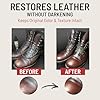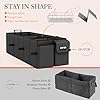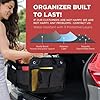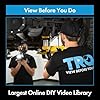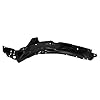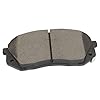Table of Contents
TAKE ACTION TODAY!
As a car owner, I can understand how frustrating it is to have stopped ABS valves, especially when time is running out. If the ABS is not taken care of properly, expensive fixes could be needed if nothing is done right away.
But instead of calling a professional right away, it’s important to know that there are ways to get rid of them yourself.
First, remove the screws from the control box and lift the connector. Next, heat the valve stems and apply the cleaning solution. After that, force air into the ports and apply rust remover. Try to get the air out of the ABS, and your brakes won’t rust.
In this article, I’ll show you step-by-step how to unstick ABS valves. At the end of this article, you’ll have the confidence and information to fix your ABS valves and get back on the road safely. So let’s get started!
DBPOWER Peak 3000A 18000mAh Portable Car Jump Starter (up to 8.0L Gas, 6.0L Diesel Engine) Battery Booster with Smart Charging Port, Compass, LCD Screen and LED Light (Black/Red)
Weize YTX5L-BS High Performance – Maintenance Free – Sealed AGM Motorcycle CTX5L Battery compatible with Honda YUASA Yamaha ETX5L-BS Batteries
Bick 4 Leather Conditioner and Leather Cleaner 2 oz – Will Not Darken Leather – Safe of Leather Apparel, Furniture, Jackets, Shoes, Auto Interiors, Bags & All Other Leather Accessories
EYYA Handheld Vacuum Cordless, 16KPA High Power Portable Car Vacuum Cleaner & Air Duster, Hand Held Vacuum Cordless Rechargeable with Multi-Nozzles & 2 HEPA Filters for Car Home Office
PULIDIKI Car Cleaning Gel Clean Putty Car Interior Cleaner Slime Auto Detail Tools Kit Supplies Car Accessories Christmas Stocking Stuffers Gifts for Men Women White Elephant Gifts Adults Teens
NOCO Boost GB70: 2000A UltraSafe Jump Starter – 12V Lithium Battery Booster Pack, Portable Jump Box, Power Bank & Jumper Cables – for 8.0L Gas and 6.0L Diesel Engines
TeSabMi Car Cleaning Gel Car Cleaning Putty Car Putty Car Interior Cleaner Car Slime Car Detailing Kit Car Accessories Gifts for Men Women Stocking Stuffers
HOTOR Trunk Organizer, Sturdy Foldable with Cooler for Car & SUV, 3 Compartments, Black, 30.90”×12.60”×10.63”
ETENWOLF T300 Digital Tire Pressure Gauge 3-200 PSI, Industrial Tire Gauge Calibrated to ANSI B40.7 Grade 2A(Plus-Minus 0.5%), Replaceable AAA Batteries (Vivid Orange)
ANCEL AD310 Classic Enhanced Universal OBD II Scanner Car Engine Fault Code Reader CAN Diagnostic Scan Tool, Read and Clear Error Codes for 1996 or Newer OBD2 Protocol Vehicle (Black)
Understanding ABS Valves:
Understanding the function of ABS valves is essential for resolving the issue of blocked ABS valves.
To ensure that all four wheels receive the necessary quantity of braking force, these valves are responsible for regulating the brake system’s hydraulic pressure.
The loss of responsiveness of these valves can impair the performance of the anti-lock braking system and restrict the passage of brake fluid.
Symptoms of A Bad ABS Modulator Valve:
There are several signs of a bad ABS module, which may affect the proper function of your braking system, including:
- There may be a locking of the brake pedal
- Inaccurate speedometer readings may occur
- You may not be able to brake
- While driving, your ABS light might stay on
- The wheels don’t brake evenly.
- Grinding and squealing noises while braking.
Tire Inflator Portable Air Compressor, 6X Fast 150PSI Air Pump for Car Tires, Cordless Car Motorcycle Balls Bike Pump, Tire Inflator Pressure Gauge, 12V Auto Shut-off Tire Pump, LED Display&Light
SCITOO New Alternator Fits for Honda for Pilot 2012-2015,for Odyssey 2011-2013,for Ridgeline 2012-2014,3.5L 3471CC V6,130A High-output CW 6-Groove,Replace OE 104210-1240 31100-RV0-A01 11573 290-5582
TRUNKCRATEPRO Trunk Organizer For Car, Suv, Truck | Premium Adjustable Multi Compartments Collapsible Car Trunk Organizer With Securing Straps & Non-Slip Bottom (Large Size, Black)
Tuningpros WD2-070i Dark Smoke 4 Pcs Set Window Visor (in-Channel) Deflector Rain Guard Compatible with 2006-2011 Chevrolet HHR
$63.80 (as of December 22, 2025 06:12 GMT +00:00 – More infoProduct prices and availability are accurate as of the date/time indicated and are subject to change. Any price and availability information displayed on [relevant Amazon Site(s), as applicable] at the time of purchase will apply to the purchase of this product.)TRQ Front Right Inner Fender Liner Passenger Side Compatible with 2006-2011 Honda Civic HO1249134
Magic Car Scratch Removal Pen, Professional Repair Solution For All Cars, Works On Any Color To Fix Scratches Swirl Marks And Scuffs, Easy DIY Paint Restoration Kit For A Seamless Finish (1)
Tire Inflator Portable Air Compressor, 150 PSI Faster Cordless Air Pump for Car Tires, Electric Bike Tire Pump with Digital Pressure Gauge, LED Light for Motorcycle, Bicycle, Ball
Tuningpros WV-197 Outside Mount Window Visor Deflector Rain Guard Dark Smoke 2-pc Set, Compatible with 2010-2013 Ford Transit Connect
$47.19 (as of December 22, 2025 01:04 GMT +00:00 – More infoProduct prices and availability are accurate as of the date/time indicated and are subject to change. Any price and availability information displayed on [relevant Amazon Site(s), as applicable] at the time of purchase will apply to the purchase of this product.)Upgrade Nylon Universal Cable Tie Buckle with Clear Storage Box – Cable Tie Buckle Zip Tie Clips for Car Fender, Engine Cover, Mudguard Fastener, Automotive Replacement Screw Fixing, 100PCS
nacena Snow Brush and Ice Scrapers for Car Windshield, Detachable Snow Remover for Cars EVA Foam Grip and Rotatable Brush Head Snow Scraper for Car Trucks SUV, Winter Cars Accessories (Orange)
There’s a good chance that you have got an abs solenoid valve malfunction if you notice any of these signs.
[azonpress_tables id=”5″]
Precautions and Safety Measures:
To prevent any damage to your braking system, you should take these precautions before attempting to unstick ABS valves:
- Be sure that the area where you park your vehicle is flat and stable.
- Make sure the parking brake is engaged and the wheels are chocked.
- Safety glasses and gloves should be worn.
- For specific instructions and warnings, refer to the owner’s manual of your vehicle.
How Do You Clean ABS Valves?
You should clean your ABS valves even if they aren’t a priority for you, since if they aren’t maintained, dirt and sludge can spread dangerous toxins throughout your vehicle.
You will need considerable time and effort to access the pipes and hoses located deep within your vehicle.
TRQ Driver Side Mirror Assembly Power Heated Blind Spot Foldaway Paint to Match Compatible with 2013-2017 Toyota Sienna
Magic Car Scratch Removal Pen, Professional Repair Solution For All Cars, Works On Any Color To Fix Scratches Swirl Marks And Scuffs, Easy DIY Paint Restoration Kit For A Seamless Finish (1)
EYYA Handheld Vacuum Cordless, 16KPA High Power Portable Car Vacuum Cleaner & Air Duster, Hand Held Vacuum Cordless Rechargeable with Multi-Nozzles & 2 HEPA Filters for Car Home Office
Tire Inflator Portable Air Compressor – 150PSI Cordless Air Pump for Car Tires, Portable Tire Inflator for Car, DC 12V Air Compressor with Pressure Gauge/LED Light for Auto/Bike/Motorcycle/Ball
Tuningpros WD2-070i Dark Smoke 4 Pcs Set Window Visor (in-Channel) Deflector Rain Guard Compatible with 2006-2011 Chevrolet HHR
$63.80 (as of December 22, 2025 06:12 GMT +00:00 – More infoProduct prices and availability are accurate as of the date/time indicated and are subject to change. Any price and availability information displayed on [relevant Amazon Site(s), as applicable] at the time of purchase will apply to the purchase of this product.)Kids Dirt Bike Helmets Youth Motorcycle Helmet, Kids Motorcycle Full Face Helmet for Off-Road, ATV, UTV, Street Riding with Goggles Gloves, DOT Approved
Jump Starter with Air Compressor, 5000A Battery Jumper Starter Portable (9L Gas/8L Diesel) with 160PSI Auto-Shutoff Tire Inflator, 12V Jump Box Car Battery Jump Starter with Jumper Cables, LED Light
JOLTEKON Car Battery Jump Starter with Air Compressor 4500A 150PSI, Car Jumper Starter Portable (9L Gas/8L Diesel), Jump Box Car Battery with Auto-Shutoff Tire Inflator, Jumper Cables and Light
67% Offpopalula Windshield Chip Repair Kit – 2026 Upgrade Car Windshield Crack Repair Kit, Glass Repair Liquid for Cracks and Chips, Rock Chip Repair Kit for Fix Windows, Mirrors, Glasses, All Crack Types
NEVERLAND Tire Inflator Portable Air Compressor – Cordless & 12V DC Air Pump for Car Tires, 150 PSI Bike Pump With Gauge, Auto-Shutoff Tire Pump for Car Bicycle Motorcycle Ball(1 Year Warranty)
An ABS valve can easily be cleaned with a few simple materials, such as:
- Cleaning Solutions
- Rubber Gloves
- A Sponge
- A Bowl
The first thing you need to do is wear rubber gloves, then take out the engine compartment and remove the battery. Next, use a sponge to apply some cleaning solution to get all the sludge out.
As soon as you’re finished, make sure to clean out the bowl thoroughly to prevent the liquid from seeping back into your car’s engine.
How to Un-stick ABS Valves:
Several individuals could benefit from my knowledge after noticing the abs module failure symptoms. I noticed that my brake pedal felt excessively firm while driving and sometimes appeared to be stuck at times.
After discussing it with my friend, a professional mechanic, we concluded that the ABS valves were to blame.
First, remove the fuse panel cover so you’ll have enough space to remove the control module bolts.
You can make it easier to access the control module by pushing the push connector upwards. To remove the swingable cover, press the clip at the bottom.
Auto Amazon Links: No products found. (58 items filtered out)
About twelve valves are expected in the pump, but extracting them is challenging because they’re sealed. To get past this, heat the stems of the valves and wipe the ports with a cleaner. You’ll get the ABS valves released this way.
Apply a rust dissolver after injecting air into the ports with an air compressor.
Blowing air for a few minutes can get rid of rust particles that were emitted from the valves after exposure to rust remover.
After everything’s been cleared, put everything back in its place since the valves are no longer rusted.
How To Bled ABS Module Without a Scanning Tool?
While mastering the technique of bleeding the ABS module without a scanner may require more time and effort, it is a simple one. Following are some steps you can take without a scanner to bleed the ABS module:
Tools needed:
- Wrench
- Jack
- Drip Pan
- Piece of Cloth
- New Oil
- A Transparent Plastic Tube
- Empty Bottle
Once the necessary equipment has been obtained, it is necessary to remove the wheel with a car jack and identify the bleeders. After locating the bleeders, remove the lower portion of the wheel to reveal the metal line containing a cap.
Auto Amazon Links: No products found. (85 items filtered out)
A drip pan should be placed beneath the metal lines before draining the fluid with a wrench.
Once the brake fluid has been discharged from the bleeders, start manually pressing the brake pedal repeatedly. Your vehicle’s four brakes should be inspected in this manner.
Add oil to the tank after it has been cleaned. If there are no problems with the brake pedal, then you can check the brakes.
How To Bleed ABS Module Using A Scanning Tool:
New vehicles must be scanned to ensure that the valves are functioning properly so air can pass through them.
After starting your car and attaching the diagnostic tool, navigate effortlessly to the appropriate diagnostic menus using the accompanying manual.
Your software should let you choose which part of your brakes you want to bleed after you locate the right menu.
Follow the instructions and your system will start bleeding your brakes once you’ve selected the ones you need.
FAQs (How To Un-stick ABS Valves):
Q: How Do I Know If My ABS Solenoid Valve Malfunction?
Ans: The following are the symptoms of a bad abs modulator valve:
Braking pedals that pulse
Pressure loss in the brakes
Longer braking distances
When braking, there is an unusual noise
Dashboard ABS warning light
Difficulty to control or stop the vehicle during braking
The ABS modulator valve should be diagnosed and repaired by a professional technician if you see any of the signs of a bad ABS module.
Q: How Do You Clean ABS Hydraulic Units?
Ans: Experts need to have the right tools and know-how to clean the ABS hydraulic unit. Take your vehicle to a good service center or ask a qualified mechanic if you think your ABS hydraulic unit is having problems.
For those who insist on doing it themselves, this video may be helpful.
Q: How Do You Bypass An ABS Pump?
Ans: If you want your brakes to work safely, don’t bypass the ABS pump. While braking, the ABS pump prevents the wheels from locking up and maintains control over the vehicle.
A professional technician can check and fix your ABS pump if it’s malfunctioning so your brakes work properly.
Q: What Does the ABS Dump Valve Do?
Ans: The ABS dump valve relieves brake pressure during antilock braking events through the release of brake fluid.
In order to prevent skidding, the ABS system opens a dump valve when it detects wheel lock-up to temporarily release brake pressure.
As a result, the car is more stable and controllable during braking, especially when the surface is slippery or uneven.
Q: Will Disconnecting the Battery Reset the ABS Module?
Ans: The ABS module cannot be reset by removing the battery because cars have complex computer systems. Using a professional diagnostic tool or seeing a mechanic is the best way to reset the ABS module.
They’ll access your car’s onboard diagnostic system and set it up the right way.
Q: How Many Valves Are There In the ABS Module?
Ans: There are 12 valves in an ABS module. Four valves prevent the master cylinder from giving pressure to a specific wheel, while eight valves control the brake force for each wheel. Anti-lock brakes are controlled by this valve system.
Q: Should I Bleed the Brakes With The Engine Running?
Ans: It is not necessary to run the engine when bleeding the brakes. During brake bleeding, the air is removed from the brake lines to ensure the brakes are working efficiently. The engine should be off when doing this.
An engine running can make it difficult for the brake system to get rid of air since it needs a vacuum boost from the engine.
If you press the brake pedal repeatedly until it feels firm, you will be able to remove air from the brake lines.
Q: Can Air In Brake Lines Cause ABS Light?
Ans: The ABS light does not usually come on when there is air in the brake lines. The ABS light indicates that the ABS system has a problem, such as a broken sensor or valve.
The brakes can, however, be adversely affected by air in the brake lines.
A professional should be able to check and fix your brakes if you suspect they are leaking or if the ABS light is on.
Q: Is It Ok To Use Motor Oil Instead Of Brake Oil?
Ans: It is not recommended to replace brake fluid with motor oil. It can handle high temperatures and pressures because brake fluid is made for brakes.
It is possible for your brakes to fail or become damaged if you use motor oil.
No other fluid should be used besides the brake fluid recommended by the vehicle manufacturer.
Conclusion (Unsticking ABS valves):
Any driver who experiences a stuck ABS valve knows how frustrating it can be. Fortunately, your car’s brake system can be restored to its proper functioning state using the right tools and techniques.
As part of the process of unsticking ABS valves, one must identify the problem, assess the severity of the problem, and then take the appropriate action to resolve the issue.
When working with ABS valves, make sure you follow the manufacturer’s instructions. Make sure you keep your valves maintained and inspected regularly so you don’t get stuck valves in the first place.
Make sure the ABS system runs smoothly and safely by following these tips. If you ever get a stuck valve, take a deep breath, follow these steps, and you’ll be able to fix it in no time!













